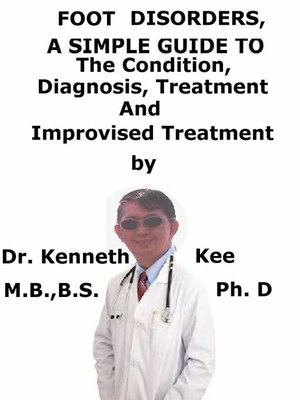Foot Disorders, a Simple Guide to the Condition, Diagnosis, Treatment and Improvised Treatment
ebook
By Kenneth Kee

Sign up to save your library
With an OverDrive account, you can save your favorite libraries for at-a-glance information about availability. Find out more about OverDrive accounts.
Find this title in Libby, the library reading app by OverDrive.



Search for a digital library with this title
Title found at these libraries:
| Library Name | Distance |
|---|---|
| Loading... |
This book describes Foot Disorders, Diagnosis and Treatment and Improvised Treatment
The human foot is a strong and complicated mechanical structure with 26 bones, 33 joints (20 of which are actively articulated), and more than one hundred muscles, tendons, and ligaments.
The joints of the foot comprise:
1. The ankle and sub-talar joint and
2. The inter-phalangeal articulations of the foot.
The human foot comprises multiple bones and soft tissues which hold up the weight of the human.
Specifically, the toes help the human while walking, supplying balance, weight-bearing, and thrust during gait.
Due to their position and function, feet are exposed to a range of possible infections and injuries, such as bunions, plantar fasciitis, and stress fractures.
Also, there are several genetic disorders that can affect the shape and function of the feet, including a club foot or flat feet.
This induces humans more vulnerable to medical disorders that are caused by poor leg and foot alignments.
Also, the wearing of shoes, sneakers and boots can hinder proper alignment and movement within the ankle and foot.
High-heeled footwear is shown to throw off the natural weight balance
This can also affect the lower back.
For the sake of posture, flat soles with no heels are advised.
Walking is a true pendulum-like gait.
The body's center of gravity moves up and down over a stiff, supporting leg causing an exchange of kinetic and possible energy (like an inverted pendulum).
The mechanics of the foot and ankle are integral to the pendulum effect, supplying a stable but moveable base of support for the body to 'vault' over through a system of 3 rockers or pivots working in the sagittal plane.
The leg is also functioning like a pendulum during 'swing phase' as it moves back and forth from the hip Joint.
Any limitation in the sagittal plane due to compromised foot or ankle function will cause compensations to happen in the frontal and transverse planes (toeing out, bow legs, over pronation).
The most frequent sagittal blocks are in the 'ankle rocker', due to reduced functional range in the ankle joint, and in the 'forefoot rocker', due to hallux valgus/hallux rigidus.
The 3 rockers create the classic heel-toe action that typically features walking in humans.
The main feature required in a 'walking shoe' is:
1. An anatomical toe box; wide, flat and foot-shaped to restore and maintain the 'forefoot rocker' and the stabilizing function of the toes.
2. Sole thickness, cushioning, heel height etc. depend on the terrain, climate, BMI and age of the walker.
The biomechanics of human locomotion can be explained by the physics of pendulums and springs.
Humans have basically 4 locomotive methods available: walking, jogging, running, sprinting.
These locomotive methods become progressively less pendulum like and more spring like as speed and gravitational loading increase and contact time decreases.
Each locomotive method has energetic and biomechanical consequences i.e. metabolic cost and risk of injury.
Skillful human movement is characterized by adopting the locomotive strategy for a given speed and terrain that make the most of economy while reducing injury risk.
Movement strategy selection is influenced by several factors such as habit, conditioning and accurate sensory feedback about the external environment.
Frequent orthopedic-related disorders are:
Foot
1. Bunions (Hallux Valgus)
2. Plantar Fasciitis
3. Foot deformities e.g., Clubfoot, Flat foot, Foot drop
4. Foot Fractures/dislocations
5. Hammer toe
6. Heel...







